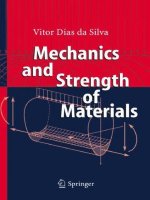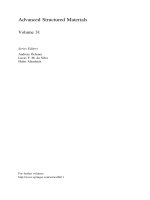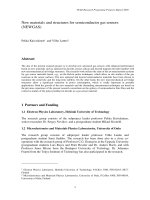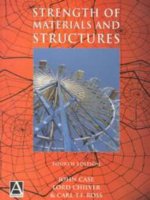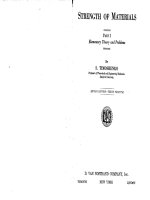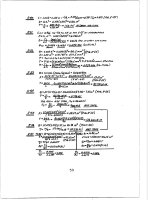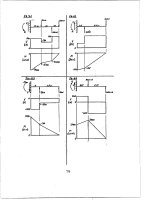Strength of materials and structures (malestrom)
Bạn đang xem bản rút gọn của tài liệu. Xem và tải ngay bản đầy đủ của tài liệu tại đây (16.16 MB, 719 trang )
Strength
of
Materials
and Structures
Fourth edition
JOHN
CASE
M.A., F.R.Ae.S.
Formerly Head
of
the Department
of
Applied Mechanics,
Royal Naval Engineering College, Plymouth
LORD
CHILVER
of
Cranfield
M.A., D.Sc., F.Eng., F.R.S.
Formerly Vice Chancellor, Cranjield Institute
of
Technologv, and
Professor
of
Civil Engineering, University College, London
CARL
T.F.
ROSS
B.S.C., Ph.D., D.Sc.,
C.
Eng., F.R.I.N.A., M.S.N.A.M.E.
Professor
of
Structural Dynamics,
University
of
Portsmouth, Portsmouth
A member
of
the Hodder Headline Group
LONDON
-
SYDNEY AUCKLAND
Co-published in North, Central and
South
America by
John Wiley
&
Sons
Inc., New York Toronto
First published in Great Britain in
1959
as
Strength
of
Materials
Reprinted
1961, 1964
Second edition
197
1
Reprinted
1985, 1986
Third edition
1993
Reprinted
1992, 1994, 1995, 1997, 1998
Fourth
edition published in
1999
by
Arnold, a member of the Hodder Headline Group,
338
Euston Road, London NWl
3BH
Co-published in North, Central and South America by
John Wiley
&
Sons Inc.,
605
Third Avenue,
New York,NY
10158-0012
0
1999
John Case, A.H. Chilver and Carl
T.F.
Ross
All rights reserved. No part of this publication may be reproduced
or
transmitted in any form or
by
any means, electronically
or
mechanically,
including photocopying, recording or any information storage
or
retrieval
system, without either prior permission in writing from the publisher
or
a
licence permitting restricted copying. In the United Kingdom such licences
are issued by the Copyright Licensing Agency:
90
Tottenham Court Road,
London WlP
9HE.
Whilst the advice and information in this book are believed to be true and
accurate at the date of going to press, neither the authors nor the publisher
can accept any legal responsibility or liability for any errors
or
omissions
that may be made.
British Library Cataloguing in Publication Data
A catalogue record for this book is available from the British Library
Library
of
Congress Cataloging-in-Publication Data
A catalog record for this book is available from the Library of Congress
ISBN
0
340 71920 6
ISBN
0
470 37980 4
(Wiley)
123456789 10
Commissioning Editor: Matthew Flynn
Cover Designer: Terry Griffiths
Printed and bound in Great Britain by J.W. Arrowsmith Ltd, Bristol
What do you think about this book? Or any other Arnold title?
Please send your comments to
Acknowledgements
I
would like to thank my wge, Anne, and my children, Nicolette and Jonathan, who have
suffered my nebulous number-crunching world of eigenvalue economisers and matrix manipulators
over many years.
My thanks are extended to Mrs. Joanna Russell and Mrs. Helen Facey for the considerable
care and devotion they showed in typing this manuscript.
CTFR,
1999
"Only when you climb the highest mountain, will
you
be aware of the
vastness that lies around
you.
"
Oscar Wilde, 1854-1 900.
0
00
cl
cl
CI
0
Chinese Proverb
-
It is better to ask a question and look a fool forfive minutes, than not
to ask a question at all and be a fool for the rest of your life.
Heaven and Hell
-
In heaven
you
are faced with an infinite number of solvable problems
and in hell you are faced with an infinite number of unsolvable
problems.
Principal notation
a
length
b
breadth
c
wave velocity, distance
d
diameter
h
depth
j
number of joints
I
length
m mass, modular ratio,
number of numbers
n
frequency, load factor, distance
p
pressure
q
shearing force per unit length
r
radius
s
distance
t
thickness
u
displacement
v
displacement, velocity
w
displacement, load intensity,
x
coordinate
y
coordinate
z
coordinate
force
a
coefficient of linear expansion
y
shearing strain
6
deflection
E
direct strain
q
efficiency
8
temperature, angle of twist
v
Poisson’s ratio
[k]
element stiffness matrix
[
m]
elemental mass matrix
A
area
C
complementary energy
D
diameter
E
young’s modulus
F
shearing force
G
shearing modulus
H
force
I
second moment of area
J
torsion constant
K
bulk modulus
L
length
A4
bending moment
P
force
Q force
R
force, radius
S
force
T
torque
U
strain energy
V
force, volume, velocity
W
work done, force
X
force
Y
force
2
section modulus, force
p
density
o
direct stress
T
shearing stress
w
angular velocity
A
deflection
@
step-function
[
K]
system stiffness matrix
[MI
system mass matrix
Note on
SI
units
The units used throughout the book are those of the Systeme Internationale d’Unites; this is
usually referred to
as
the
SI
system.
In
the field of the strength of materials and structures we
are concerned with the following basic units of the SI system:
length metre (m)
mass kilogramme (kg)
time second
(s)
temperature kelvin
(K)
There are
two
further basic units of the SI system
-
electric current and luminous intensity
-
which we need not consider for our present purposes, since these do not enter the field of the
strength of materials and structures. For temperatures we shall use conventional degrees
centigrade
(“C),
since we shall be concerned with temperature changes rather than absolute
temperatures. The units which we derive from the basic
SI
units, and which are relevant to out
fielf of study, are:
force newton
(N)
kg .m
.s-?
work, energy joule
(J)
kg.m’.s-’
=
Nm
power watt
(W)
kg.m2.s-’
=
Js-’
frequency hertz (Hz) cycle per second
pressure Pascal (Pa)
N.m-’
=
lo-’
bar
The acceleration due to gravity is taken as:
g
=
9.81m~-~
Linear distances are expressed in metres and multiples or divisions of
1
O3
of metres, i.e.
Kilometre (km)
IO’
m
metre (m) lm
millimetre (mm m
In many problems of stress analysis these are not convenient units, and others, such
as
the
centimetre (cm), which
is
lo-’ m, are more appropriate.
The unit of force, the newton (N), is the force required to give unit acceleration (ms-’) to
unit mass kg). In terms of newtons the common force units in the foot-pound-second-system
(with g
=
9.8
1
ms?) are
1
Ib.wt
=
4.45
newtons (N)
1
ton.wt
=
9.96
x
IO’
newtons (N)
x
iv
Note on
SI
units
In
general, decimal multiples in the
SI
system are taken in units
of
IO3.
The prefixes we make
most use
of
are:
kilo
k
1
o3
mega
M
1
o6
gigs
G
1
o9
Thus:
1 ton.wt
=
9.96 kN
The unit of force, the newton
(N),
is used
for
external loads and internal forces, such
as
shearing forces. Torques and bending of moments are expressed in newton-metres (Nm).
An
important unit in the strength of materials and structures is stress.
In
the foot-pound-
second system, stresses are commonly expressed
in
Ib.wt/in2, and tons/in2.
In
the
SI
system
these take the values:
1
Ib.wt/in2
=
6.89
x
103 N/m2
=
6.89 kN/m2
1 ton.wt/in2
=
15.42
x
106N/m2
=
15.42 MN/m2
Yield stresses of the common metallic materials are in the range:
200 MN/m2 to 750 MN/m2
Again, Young's modulus for steel becomes:
Estee,
=
30
x
106 Ib.wt/in2
=
207 GN/mZ
Thus, working and yield stresses will usually be expressed
in
MN/m2 units, while Young's
modulus will usually be given in GN/m2 units.
Preface
This
new edition is updated by Professor
Ross,
and whle it retains much
of
the basic and
traditional work in Case
&
Chllver’s
Strength
of
Materials and Structures,
it introduces modem
numerical techques, such as matrix and finite element methods.
Additionally, because of the difficulties experienced by many of today’s students with basic
traditional mathematics, the book includes an introductory chapter which covers in some detail the
application of elementary mathematics to some problems involving simple statics.
The 197 1 ehtion was begun by
Mr.
John
Case and Lord Chlver but, because of the death of
Mr.
John
Case, it was completed by Lord Chlver.
Whereas many of the chapters are retained in their 197 1 version, much tuning has been applied
to some chapters, plus the inclusion of other important topics, such as the plastic theory of rigid
jointed frames, the torsion of non-circular sections, thick shells, flat plates and the stress analysis
of composites.
The book covers most of the requirements for an engineering undergraduate course
on
strength
of
materials and structures.
The introductory chapter presents much of the mathematics required for solving simple
problems in statics.
Chapter 1 provides a simple introduction to direct stresses and discusses some
of
the
hdamental features under the title: Strength of materials and structures.
Chapter 2 is
on
pin-jointed frames and shows how to calculate the internal forces
in
some
simple pin-jointed trusses. Chapter 3 introduces shearing stresses and Chapter 4 discusses the
modes of failure of some structural joints.
Chapter
5
is on two-dimensional stress and strain systems and Chapter
6
is
on
thin walled
circular cylindrical and spherical pressure vessels.
Chapter
7
deals with bending moments and shearing forces in beams, whch are extended in
Chapters 13 and 14 to include beam deflections. Chapter
8
is
on
geometrical properties.
Chapters 9 and 10 cover direct and shear stresses due to the bending of beams, which are
extended in Chapter 13. Chapter 11 is
on
beam theory for beams made from
two
dissimilar
materials. Chapter 15 introduces the plastic hinge theory and Chapter 16 introduces stresses due
to torsion. Chapter 17 is on energy methods and, among other applications, introduces the plastic
design of rigid-jointed plane frames.
Chapter 18 is on elastic buckling.
Chapter 19 is on flat plate theory and Chapter 20 is
on
the torsion
of
non-circular sections.
Chapter 22 introduces matrix algebra and Chapter 23 introduces the matrix displacement
Chapter 24 introduces the finite element method and
in
Chapter
25
this method is extended to
CTFR, 1999
Chapter 21 is
on
thick cylinders and spheres.
method.
cover the vibrations
of
complex structures.
Contents
Preface
x
Acknowledgements
xi
Principal notation
xii
NoteonSIunits
xiii
Introduction
1
I.
1
Introduction
1.2
Trigonometrical definitions
1.3
Vectors and scalars
1.4
Newton’s Laws of
Motion
1.5
Elementary statics
1.6
Couples
1.7
Equilibrium
1
Tension and compression: direct stresses
12
1.1
Introduction
1.2
Stretching of a steel wire
1.3
Tensile and compressive stresses
1.4
Tensile
and compressive strains
1.6
Ductile materials
1.7
Proof stresses
1.8
Ductility measurement
1.9
Working stresses
1.10
Load factors
1.11
Lateral strains due to direct stresses
1.12
Strength properties
of
some engineering materials
1.13
Weight and stiffness economy of materials
1.14
Strain energy and work done in the tensile
test
1.15
Initial stresses
1.16
Composite bars in tension or compression
1.17
Temperature
stresses
1.18
Temperature stresses in composite bars
1.1
9
Circular ring under radial pressure
1.20
Creep of materials under sustained stresses
1.21
Fatigue under repeated stresses.
1.5
Stress-strain curves for brittle materials
2
Pin-jointed frames or trusses
55
2.1
Introduction
2.2
Statically determinate pin-jointed frames
2.3
The method ofjoints
2.4
The
method of sections
2.5
A statically indeterminate problem.
3
Shearingstress
67
3.1
Introduction
3.3
Complementary shearing stress
3.4
Shearing strain
3.5
Strain energy due to shearing actions.
3.2
Measurement of shearing stress
vi
Contents
4 Joints and connections
76
4.1
Importance of connections
4.2
Modes of failure of simple bolted and riveted joints
4.3
Efficiency of a connection
4.4
Group-bolted and -riveted joints
4.5
Eccentric loading of
bolted and riveted connections
4.6
Welded connections
4.7
Welded connections under bending
actions.
5
Analysis
of
stress and strain
94
5.1
Introduction
5.2
Shearing stresses in a tensile test specimen
5.3
Strain figures in mild steel;
Liider’s lines
5.4
Failure of materials in compression
5.5
General two-dimensional stress system
5.6
Stresses on an inclined plane
5.7
Values of the principal stresses
5.8
Maximum shearing
stress
5.9
Mohr’s circle of stress
5.10
Strains in an inclined direction
5.11
Mohr’s circle of
strain
5.12
Elastic stress-strain relations
5.13
Principal stresses and strains
5.14
Relation
between
E, G
and
v
5.15
Strain ‘rosettes’
5.16
Strain energy for a two-dimensional stress system
5.17
Three-dimensional stress systems
5.18
Volumetric strain in a material under hydrostatic
pressure
5.19
Strain energy of distortion
5.20
Isotropic, orthotropic and anisotropic
5.21
Fibre
composites
5.22
In-plane equations for a symmetric laminate or composite
5.23
Equivalent
elastic constants for problems involving bending and twisting
5.24
Yielding of ductile materials
under combined stresses
5.25
Elastic breakdown and failure of brittle material
5.26
Failure of
composites.
6 Thin shells under internal pressure
152
6.1
Thin
cylindncal shell of circular cross section
6.2
Thin spherical shell
6.3
Cylindrical shell
with hemispherical ends
6.4
Bending stresses in thin-walled circular cylinders.
7 Bending moments and shearing forces
169
7.1
Introduction
7.2
Concentrated and distributed loads
7.3
Relation between the intensity of
loading, the shearing force, and bending moment in a straight beam
7.4
Sign conventions for
bending moments and shearing forces
7.5
Cantilevers
7.6
Cantilever with non-uniformly
distributed load
7.7
Simply-supported beams
7.8
Simply-supported beam carrying a uniformly
distributed load and end couples
7.9
Points of inflection
7.10
Simply-supported beam with a
uniformly distributed load over part
of a span
7.11
Simply-supported beam with non-uniformly
distributed load
7.12
Plane curved beams
7.13
More general case of bending of a curved bar
7.14
Rolling loads and influence lines
7.16
Influence lines of bending moment and shearing force.
7.15
A
single concentrated load traversing
a
beam
8
8.1
Introduction
8.2
Centroid
8.3
Centroid axes
8.4
Second moment of area
(I)
8.5
Parallel
axes theorem.
Geometrical properties
of
cross-sections
200
Contents
vii
9
9.1
Introduction
9.2
Pure bending of a rectangular beam
9.3
Bendmg of a beam about a principal
axis
9.4
Beams having
two
axes of symmetry in the cross-section
9.5
Beams having only one
axis of symmetry
9.7
Elastic section modulus
9.8
Longitudinal stresses whle shearing forces are present
9.9
Calculation of the principal second
moments of area
9.10
Elastic strain energy of bending
9.11
Change of cross-section in pure
bending.
Longitudinal stresses in beams
212
9.6
More general case of pure bending
10
Shearing stresses in beams
245
10.1
Introduction
10.2
Shearing stresses in a beam of narrow rectangular cross-section
10.3
Beam of any cross-section having one axis of symmetry
10.4
Shearing stresses in an I-beam
10.5
Principal stresses in beams
10.6
Superimposed beams
10.7
Shearing stresses in a channel
section; shear centre.
11
Beams
of
two
materials
266
11.1
Introduction
11.2
Transformed sections
11.3
Timber beam with reinforcing steel flange
plates
11.4
Ordinary reinforced concrete.
12
Bending stresses and direct stresses combined
283
12.1
Introduction
12.2
Combined bending and thrust of a stocky strut
12.3
Eccentric thrust
12.4
Pre-stressed concrete beams.
13
Deflections
of
beams
295
13.1
Introduction
13.2
Elas’ic bending of straight beams
13.3
Simply-supported beam carrying
a uniformly distributed load
13.4
Cantilever with a concentrated load
13.5
Cantilever with a
uniformly distributed load
13.6
Propped cantilever with distributed load
13.7
Simply-supported
beam canying a concentrated lateral load
13.8
Macaulay’s method
13.9
Simply-supported beam
with distributed load over a portion of the span
13.10
Simply-supported beam
with
a couple
applied at an intermediate point
13.11
Beam with end couples and distributed load
13.12
Beams
with non-uniformly distributed load
13.13
Cantilever with irregular loading
13.14
Beams of
varying section
13.15
Non-uniformly distributed load and terminal couples; the method of
moment-areas
13.16
Deflections of beams due to shear.
14
Built-in and continuous beams
339
14.1
Introduction
14.2
Built-in beam with a single concentrated load
143
Fixed-end moments
for other loading conditions
14.4
Disadvantages
of
built-in beams
14.5
Effect of sinking of
supports
14.6
Continuous beam
14.7
Slope-deflection equations for a single beam.
Viii
Contents
15
Plastic bending of mild-steel beams
350
15.1
Introduction
153
Elastic-plastic bending of a
rectangular mild-steel beam
15.4
Fully plastic moment of an I-section; shape factor
15.5
More
general case of plastic bending
15.6
Comparison of elastic and plastic section moduli
15.7
Regions of plasticity in a simply-supported beam
15.8
Plastic collapse of a built-in beam.
15.2
Beam of rectangular cross-section
16
Torsion of circular shafts and thin-walled tubes
367
16.1
Introduction
163
Torsion of solid circular shafts
16.4
Torsion
of a hollow circular shaft
16.5
Principal stresses in a twisted shaft
16.6
Torsion
combined with thrust or tension
16.7
Strain energy of elastic torsion
16.8
Plastic torsion of a
circular shaft
16.9
Torsion of
thin
tubes of non-circular cross-section
16.10
Torsion of a flat
rectangular strip
16.11
Torsion of thin-walled open sections.
16.2
Torsion of a
thin
circular tube
17
Energymethods
390
17.1
Introduction
17.2
Principle of virtual work
17.3
Deflections of beams
17.4
Statically
indeterminate beam problems
17.5
Plastic bending of mild-steel beams
17.6
Plastic design of
frameworks
17.7
Complementary energy
17.8
Complementary energy in problems of bending
17.9
The Raleigh-Ritz method.
18
Buckling of columns and beams
424
18.1
Introduction
18.2
Flexural buckling of a pin-ended strut
183
Rankine-Gordon formula
18.4
Effects of geometrical imperfections
18.5
Effective lengths of
struts
18.6
Pin-ended strut
with eccentric end
thrusts
18.7
Initially curved pin-ended strut
18.8
Design of pin-ended struts
18.9
Strut with uniformly distributed lateral loading
18.10
Buckling of a strut with built-in ends
18.11
Buckling of a strut with one end fixed and the other end free
18.12
Buckling of a strut with
one end pinned and the other end fixed
18.13
Flexural buckling of
struts
with other cross-
sectional
forms
18.14
Torsional buckling of a cruciform strut
18.15
Modes of buckling of a
cruciform strut
18.16
Lateral buckling of a narrow beam.
19
Lateral deflections of circular plates
458
19.1
Introduction
193
Large deflections of plates
19.4
Shear deflections of very thick plates.
19.2
Plate differential equation, based on small deflection elastic theory
Contents
ix
20
Torsion of non-circular sections
492
20.1
Introduction
20.2
To
determine the torsional equation
20.3
To
determine expressions for
the shear stress
T
and the torque
T
20.4
Numerical solution of the torsional equation
20.5
Prandtl's membrane analogy
20.6
Varying circular cross-section
20.7
Plastic torsion.
21
Thick circular cylinders, discs and spheres
515
21.1
Introduction
21.2
Derivation of the hoop and radial stress equations for a thick-walled
circular cylinder
21.3
Lam6 line
21.4
Compound tubes
21.5
Plastic deformation of thick tubes
21.6
Thick spherical shells
21.7
Rotating discs
21.8
Collapse of rotating rings.
22
Introduction to matrix algebra.
550
22.1
Introduction
22.2
Definitions
22.3
Matrix addition and subtraction
22.4
Matrix
multiplication
22.5
Some special types of square matrix
22.6
Determinants
22.7
Cofactor and
adjoint matrices
22.8
Inverse of a matrix
[A].'
22.9
Solution of simultaneous equations.
23
Matrix methods of structural analysis
565
23.1
Introduction
23.2
Elemental stiffness matrix for a rod
23.3
System stiffness matrix
[K]
23.4
Relationship between local and global co-ordinates
23.5
Plane rod element in global co-
ordinates
23.6
Pin-jointed space trusses
23.7
Beam element
23.8
Rigid-jointed plane frames.
24
The finite element method
627
24.1
Introduction
24.2
Stiffness matrices for some typical finite elements.
25
Structuralvibrations
643
25.1
Introduction
25.2
Free vibrations of a mass
on
a beam
25.3
Free vibrations of a beam with
distributed mass
25.4
Forced vibrations of a beam carrying a single mass
25.5
Damped free
oscillations of a beam
25.6
Damped forced oscillations of a beam
25.7
Vibrations of a beam with
end thrust
25.8
Derivation of expression for the mass matrix
25.9
Mass matrix for a rod element
25.10
Mass matrix for a beam element
25.1
1
Mass matrix for a rigid-jointed plane frame element
25.12
Units in structural dynamics.
Answers to further problems
691
Index
699
Introduction
1.1
Introduction
Stress analysis is an important part of engineering science, as failure
of
most engineering
components is usually due to stress. The component under a stress investigation can vary from the
legs of an integrated circuit to the legs of an offshore drilling rig, or from a submarine pressure hull
to the fuselage of a jumbo jet aircraft.
The present chapter will commence with elementary trigonometric definitions and show how
elementary trigonometry can be used for analysing simple pin-jointed frameworks (or trusses).
The chapter will then be extended to define couples and show the reader how to take moments.
1.2
Trigonometrical definitions
Figure
1.1
Right-angled triangle.
With reference to Figure
I.
1,
sin8
=
bc/ac
cos8
=
ab/ac
(1.1)
tan0
=
bdab
For a triangle without a right angle in it, as
shown
in Figure
1.2,
the
sine
and
cosine
rules can be
used to determine the lengths of
unknown
sides or the value of
unknown
angles.
2
Introduction
Figure
1.2.
Triangle
with
no
right
angle.
The
sine
rule
states that:
C
(1.2)
-
a
b
-
sin
A
sin
B
sin
C
where
a
=
length of side BC; opposite the angle A
b
=
length of side
AC;
opposite the angle B
c
=
length of side AB; opposite the angle
C
The cosine rule states that:
a’
=
b2
+
c2 -2bc
cos
A
1.3
Vectors and scalars
A scalar is a quantity which has magnitude but no direction, such as a mass, length and time.
A
vector is a quantity which has magnitude and direction, such as weight, force, velocity and
acceleration.
NB
It is interesting to note that the moment of a couple, (Section
1.6)
and energy
(Chapter
17),
have the same units; but a moment of a couple is a vector quantity and
energy is a scilar quantity.
1.4
Newton’s
laws
of
motion
These are very important
in
engineering mechanics, as they form the very fundamentals of this
topic.
Newton’s three laws of motion were first published by Sir lsac Newton in
The
frincipia
in
1687,
and they can be expressed as follows:
(1)
Every body continues in its state of rest
or
uniform motion
in
a straight line, unless it is
compelled by an external force
to
change that state.
3
(2)
The rate
of
change of momentum of a body with respect to time, is proportional to the
resultant force, and takes place in a direction
of
which the resultant force acts.
Action and reaction are equal and opposite.
(3)
1.5
Elementary
statics
The trigonometrical formulae of 1.2 can be used
in
statics. Consider the force
F
acting on an angle
8
to the horizontal, as shown by Figure 1.3(a). Now as the force
F
is a vector, (i.e. it has magnitude
and direction), it can be represented as being equivalent to its horizontal and vertical components,
namely
FH
and
F,,
respectively, as shown by Figure 1.3(b). These horizontal and vertical
components are also vectors,
as
they have magnitude and direction.
NB
If
F
is drawn
to
scale, it is possible to obtain
FH
and
F,
from the scaled drawing.
(a) (b)
Figure
1.3
Resolving
a
force.
From elementary trigonometry
-
F~
=
case
F
:.
FH
=
F
cos &horizontal component of
F
Similarly,
5
=
sin
e
F
:.
F,
=
F
sin e-vertical component
of
F
4
Introduction
Problem
1.1
Determine the forces in the plane pin-jointed framework shown below.
1
r
I,
I
("01
IC
Solution
Assume all unknown forces in each member are in tension, i.e. the internal force
in
each
member is pulling away from
its
nearest joint, as shown below.
Isolate joint
A
and consider equilibrium around the joint,
Elementary
statics
5
Resolving forces vertically
From Section 1.7
upward forces
=
downward forces
0
=
5
+
F2
COS
30
5
cos
30
The negative sign for
F2
indicates that
hs
member is in compression.
Resolving forces horizontally
From Section 1.7
F
=
=
-5.77kN(cornpression)
or
2
forces to the left
=
forces to the right
F, +F,~in30
=O
F,
=
-
F2
sin
30
=
5.77
sin
30
F,
=
2.887
kN
(tension)
The force diagram is as follows:
Another method of determining the internal forces
in
the
truss
shown
on
page
4
is through the
use of the triangle of forces. For
hs
method, the magnitude and the direction of the known force,
namely the
5kN
load
in
hs
case, must be drawn to scale.
6
Introduction
To
complete the triangle, the directions of the unknown forces, namely
F,
and
F2
must be drawn,
as
shown
above.
The
directions
of
these forces can then be drawn by adding the arrowheads
to
the
triangle
so
that the arrowheads are either all in a clockwise direction or, alternatively, all in a
counter-clockwise direction.
Applying the sine rule to the triangle of forces above,
5
4
-=-
sin60 sin
30
5x
05
0.866
=
2.887
kN
:.F,
=-
Similarly by applying the sine rule:
5
-
=
F2
sin 60 sin
90
=
5.77
kN
5
0.866
:_
F2
=
-
These forces can now be transferred to the joint
A
of the pin-jointed
truss
below, where it can be
seen that the member with the load
F,
is in tension, and that the member with the load
F2
is
in
compression.
This
is known as a free body diagram.
1.6
Couples
A
couple can be described as the moment produced by
two
equal and opposite forces acting
together, as shown in Figure
1.4
where,
the moment at the couple
=
M
=
F
x
1
(N.m)
F
=
force
(N)
I
=
lever length (m)
Couples
7
Figure
1.4
A
clockwise couple.
For the counter-clockwise couple of Figure
1.5,
M
=
FCOS
0
x
1
where
F
cos
0
=
the force acting perpendicularly to the lever of length
1.
NB
The components of force
F
sin
0
will simply place the lever in tension, and will not cause
a moment.
Figure
1.5
A
counter-clockwise couple.
It should be noted from Figure 1.4 that the lever can be described as the perpendicular distance
between the line of action of the two forces causing the couple.
Furthermore, in Figure
1.5,
although the above definition still applies, the same value of couple
can be calculated, if the lever is chosen as the perpendicular distance between the components of
the force that are perpendicular to the lever, and the forces acting on this lever are in fact those
components of force.
8
Introduction
1.7
Equilibrium
This
section will be limited to one- or two-dimensional systems, where all the forces and couples
will be acting
in
on plane; such a system of forces is called a coplanar system.
In
two dimensions, equilibrium is acheved when the following laws are satisfied:
(1)
(2)
(3)
To
demonstrate the use of these two-dimensional laws
of
equilibrium, the following problems will
be considered.
upward forces
=
downward forces
forces to the left
=
forces to the right
clockwise couples
=
counter-clockwise couples.
Problem
1.2
Determine the values of the reactions
R,
and
RE,
when a beam is simply-
supported at its ends and subjected to a downward force of
5
kN.
Solution
For
this
problem, it will be necessary to take moments. By taking moments, it is meant that the
values
of
the moments must be considered about a suitable position.
Suitable positions for takmg moments on this beam are
A
and
B.
This
is because, if moments
are taken about
A,
the unknown section
R,
will have no lever and hence, no moment about
A,
thereby
simplifying
the arithmetic. Similarly, by talung moments about
B,
the unknown
RE
will
have no lever and hence, no moment about
B,
thereby simplifying the arithmetic.
Taking moments
about
B
clockwise moments
=
counter-clockwise moments
R,x(4+2)
=
5x2
or
R,
=
1016
Equilibrium
9
RA
=
1.667
kN
Resolving forces vem'cally
upward forces
=
downward forces
R,+R,
=
5
or
R,
=
5
-
R,
=
5
-
1.667
R,
=
3.333kN
Problem
1.3
Determine the values of the reactions of
R,
and
R,
for the simply-supported
beam
shown.
Solution
Taking moments about
B
clockwise couples
=
counter-clockwise couples
RAx4
=
3~6+10~2
18
+
20
RA
=
-
4
RA
=
9.5
kN
Resolving forces vertically
RA+RB
=
3+10
or
R,
=
13
-
9.5
=
3.5
kN
Further problems
(answers
on
page
691)
Problem
1.4
Determine the reactions
RA
and
R,
for the simply-supported beams.
10
Introduction
Problem
1.5
Determine
the
forces
the
pin-jointed
trusses
shown.
Further problems
11
I
Tension and compression:
direct stresses
1
.I
Introduction
The strength of a material, whatever its nature, is defined largely by the internal stresses, or
intensities of force, in the material.
A
knowledge of these stresses
is
essential
to
the safe design
of a machine, aircraft, or any type of structure. Most practical structures consist of complex
arrangements of many component members; an aircraft fuselage, for example, usually consists
of
an elaborate system of interconnected sheeting, longitudmal stringers, and transverse rings. The
detailed stress analysis of such a structure is a difficult task, even when the loading condhons are
simple. The problem is complicated further because the loads experienced by a structure are
variable and sometimes unpredictable. We shall be concerned mainly with stresses in materials
under relatively simple loading conditions; we begin with a discussion of the behaviour of a
stretched wire, and introduce the concepts of direct stress and strain.
1.2
Stretching
of
a
steel wire
One of the simplest loading conditions of a material is that of
tension,
in which the fibres of the
material are stretched. Consider, for example, a long steel wire held rigidly at its upper end, Figure
1.1,
and loaded by a mass hung from the lower end. If vertical movements of the lower end are
observed during loading it will be found that the wire is stretched by a small, but measurable,
amount from its original unloaded length. The material of the wire is composed of a large number
of small crystals which are only visible under a microscopic study; these crystals have irregularly
shaped boundaries, and largely random orientations with respect to each other; as loads are applied
to
the wire, the crystal structure of the metal is distorted.
Figure
1.1
Stretching
of
a
steel wire under end
load.
